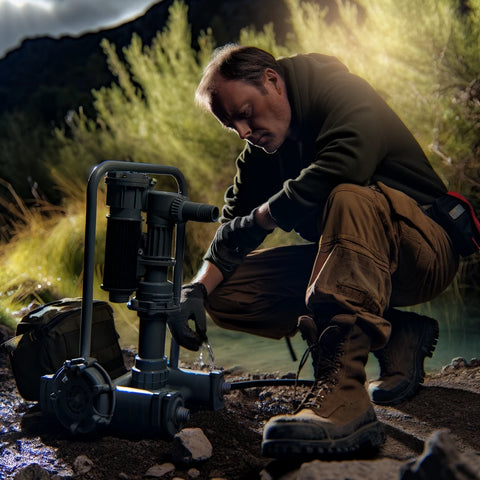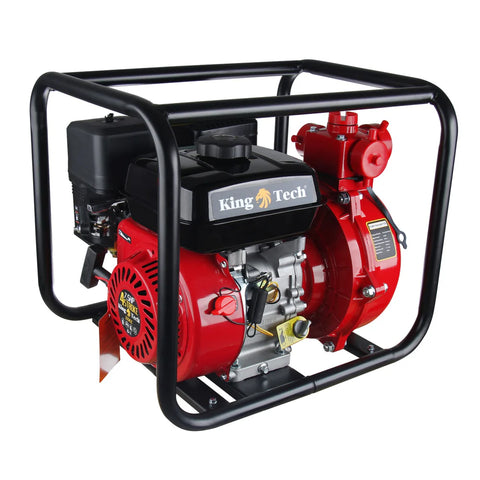Discover the essential world of water pumps with our in-depth guide, designed to demystify the operation, installation, and maintenance of these crucial devices. Water pumps play a pivotal role in residential, agricultural, and industrial settings, facilitating the efficient movement of water for a variety of purposes.
This guide will take you through the basics of how these pumps work, provide step-by-step instructions on connecting it to a water tank, and reveal the secrets to effectively priming your pump for optimal performance.
Join us as we dive into the dynamic world of water pumps, where knowledge is the first step towards efficient water management.
The Mechanics of Water Pumps Explained

Understanding how a water pump functions is essential for anyone looking to utilize this technology for water transfer, irrigation, or any water-related needs. At its core, a water pump is a device that moves water from one location to another using mechanical action. Here's a deeper look into the workings of various types of water pumps and their applications.
The Basic Principle
All water pumps operate on the basic principle of converting mechanical energy from a motor into water movement. This process involves two key stages: suction and discharge. During the suction phase, the pump creates a vacuum that draws water into the pump. In the discharge phase, this water is then pushed out to its intended destination under pressure.
Types of Water Pumps and Their Workings
- Centrifugal Pumps: These are the most common type of water pump, used extensively for a variety of applications. They work by using a rotating impeller to create centrifugal force, which pushes water outwards from the pump’s center and directs it into a discharge pipe. Centrifugal pumps are ideal for moving water over large distances and are commonly used in municipal water and wastewater plants, irrigation, and industry.
- Submersible Pumps: Designed to operate while submerged in water, submersible pumps are sealed against water ingress and are powered by a waterproof electric motor. These pumps are typically used in deep wells, boreholes, and to manage water in underground and underwater applications.
- Diaphragm Pumps: Also known as a membrane pumps, these pumps use a combination of the reciprocating action of a rubber, thermoplastic, or Teflon diaphragm and suitable valves on either side of the diaphragm to pump a fluid. Diaphragm pumps are especially useful in applications that require a gentle handling of the water or fluid, such as in the chemical and food industries.
The Role of the Motor

The motor is the heart of a water pump, providing the energy required to move the water. Electric motors are the most common, but in areas without access to electricity, gasoline or diesel motors can also be used. The power of the motor directly influences the capacity of the water pump to move water at various rates, known as the flow rate, which is measured in gallons or liters per minute.
Understanding Water Flow
The water flow process from source to destination is governed by several factors, including the power of the pump, the height to which the water needs to be lifted (head), and the resistance encountered in pipes and fittings (friction loss). A well-designed water pump system takes these factors into account to achieve efficient water movement.
Water pumps are versatile and vital tools for managing water distribution in a variety of settings. From agricultural fields to urban water systems, understanding how these devices work is the first step towards leveraging their power for efficient water management.
Connecting Your Water Pump to a Tank

Successfully linking a water pump to a water tank is a fundamental task for efficient water management across various settings. Here's a concise guide to achieve a secure connection:
Necessary Tools and Materials:
- Pipe wrenches, Teflon tape, compatible pipes and fittings, hose clamps, rubber washer-seals, and a screwdriver.
Steps for Connection:
- Measure and Cut Pipes: Determine the needed pipe length between your pump and tank and cut accordingly.
- Seal Connections: Wrap Teflon tape around the threads of both the pump outlet and tank inlet to prevent leaks. Use pipe wrenches to tighten the fittings without over-tightening.
- Attach Hose Clamps: Secure hoses on the fittings with hose clamps, ensuring a snug fit to avoid leaks.
- Prime the Pump: Fill the pump with water to prime it, ensuring efficient operation by preventing dry running.
Key Tips:
- Always turn off the pump and disconnect it from power before starting.
- Regularly check hoses and connections for wear and replace as needed.
- Avoid over-tightening to prevent thread damage.
By adhering to these straightforward steps, you can establish a reliable water pump to tank connection, setting the foundation for effective water usage and management.
Quick Guide to Priming Your Water Pump

Priming is a must-do to kickstart your water pump’s efficiency and protect it from damage. Here's a quick walkthrough:
Why Prime?
Priming prevents dry running, which can harm your pump, and ensures a smooth water flow.
Priming Steps:
- Power Off: Confirm the pump is off and unplugged.
- Close Discharge Valve: If present, close it to keep water in during priming.
- Open Priming Plug: Find and remove the priming plug on the pump’s top.
- Fill with Water: Pour water into the pump until full, covering the internal parts and possibly the suction hose.
- Seal It Up: Replace the priming plug firmly.
- Switch On: Power up the pump and slowly open the discharge valve as it begins to work.
Priming Tips:
- Use clean water to avoid clogs.
- A foot valve at the suction line's end helps maintain prime and reduce future efforts.
A properly primed pump is key to effective and efficient water management. Follow these simplified steps to ensure your water pump operates at its best.
Maintenance and Quick Fixes
Keep your water pump running smoothly with these straightforward maintenance tips and solutions for common issues.
Maintenance Must-Dos
- Inspect and Tighten: Regularly check hoses and connections for leaks; tighten as necessary.
- Clean Regularly: Keep the pump and its filters clear of debris to prevent blockages.
- Oil Checks: For engine-driven pumps, maintain the correct oil level and change as recommended.
- Routine Testing: Operate your pump periodically to catch issues early.
Troubleshooting Common Problems
- Pump Losing Prime: Check for leaks or a faulty foot valve. Re-prime as needed.
- Filter Blockages: Clean or replace clogged filters to improve water flow.
- Motor Troubles: Clear any obstructions from cooling vents and check for secure electrical connections.
Professional Help
If problems persist or you notice unusual noises or performance drops, seek professional help. Regular expert assessments can also prevent significant issues, ensuring your pump's longevity and reliability.
Simple, regular upkeep and knowing how to address common issues can significantly extend your water pump's life and ensure its efficient operation.
Understanding and maintaining your water pump is key to ensuring its efficiency, longevity, and reliability. By following the guidelines and tips provided in this guide, you can maximize the performance of your water pump and avoid common pitfalls that lead to operational issues. Regular maintenance, coupled with prompt troubleshooting, will keep your water management systems running smoothly, saving you time and money in the long run.
Invest in a high quality water pump that offers peace of mind and ensures your water management tasks are handled with utmost efficiency. Visit our collection today and see the difference quality makes.

